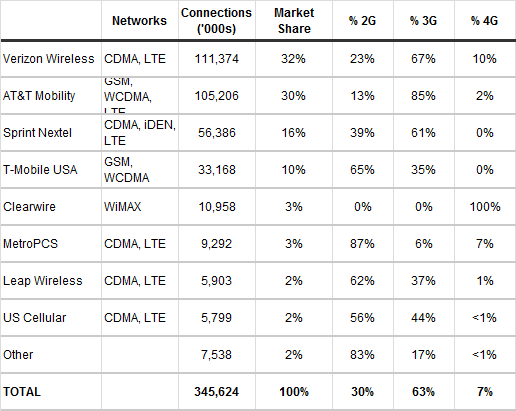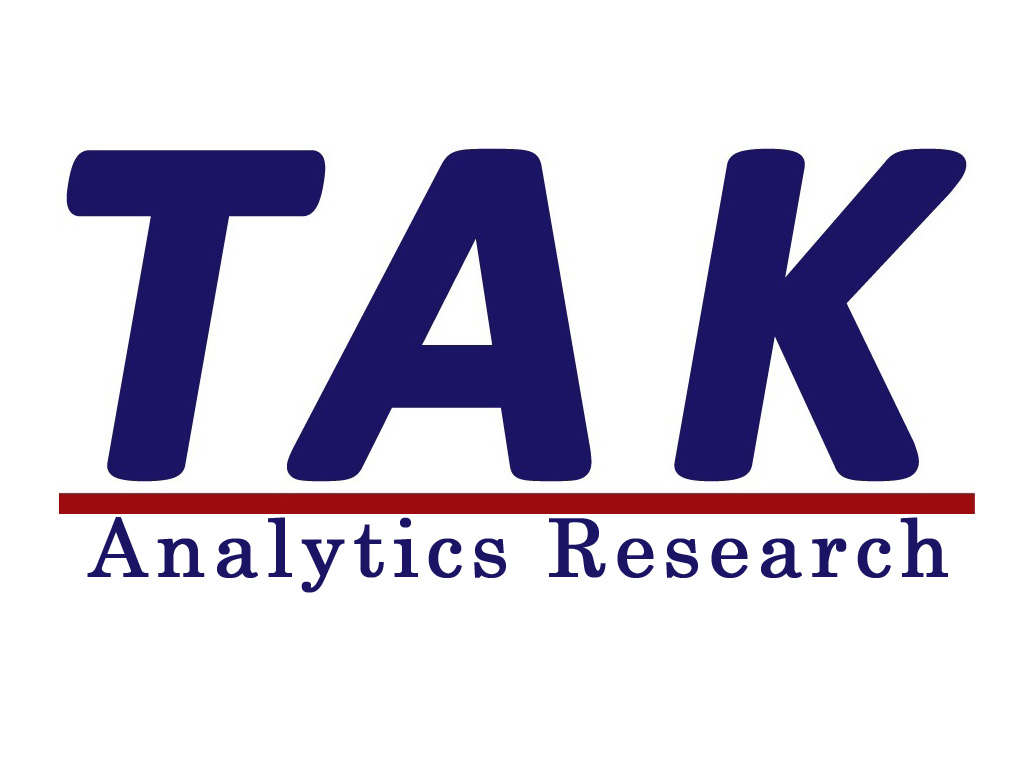●4G競争激化する米国 4G-LTEへの移行が加速、既存のネットワーク漸減
米通信事業各社は、4G-LTE への移行強化にしたがい、従来ネットワークの容量やスペクトラムの割り当て見直しを模索する動きが見られる。
Wireless Intelligence社の最新データによれば、米国のLTE接続数は2012年第2四半期時点で総計1,370万件。大韓民国(710 万件)や日本(370万件) を押さえ、世界最大のLTE市場の地位を守っている。
第2四半期の米国の総接続数のうち、LTEが占める割合は4%で、予測によれば、年末までに6%(2,000万件)に及ぶ見込みである。4Gの分類に含まれる技術をすべて合計する(LTE同様にWiMAXを追加)と、4Gの割合は第2四半期の米国の総接続数に対し、7%となる(表参照)。
米国市場を牽引するVerizon Wireless社は、他社を大きく引き離し、単独世界一の規模を誇るLTE通信事業者として君臨している。第2四半期のLTE接続数は1,000万件を超え、米国LTE接続の約8割を占める。VerizonのLTEネットワークは、現在、371地域の市場で稼動しているが、これは推計で人口の75%に当たる。同社は年末に向けてさらにカバー率を広げ、400市場で稼動させるよう計画中だ。
Verizon社が擁する接続数基盤のうち、2/3は依然として3G-CDMAネットワークを使用しているが、加入者のLTE移行が加速するにつれ、その数は減少傾向にある。まもなくCDMA帯域のLTEへの割り当て直しに着手すると目されてきた同社だが、何人もの幹部社員の発言により、その変化にはまだ「長い長い時間」がかかる(場合によっては、台頭中のM2M市場を支えるためか)と伝えられている。
AT&T社のLTEネットワークは、目下、72地域の市場で稼動中であり、米国第2位の同社が第2四半期に記録した総接続数中のLTE比率は2%。Verizon社と異なり、AT&T社はLTEを現行の高速3Gネットワークの発展形として位置づけている。同社のマーケティングではHSPA+を4Gとして分類しているほどである(このため、同社は、Verizon社より3,000も多い都市で4G接続を実現していると主張している)。AT&T社は2012年末までにLTEカバー率を前年比2倍に押し上げ、来年末までにはLTE展開を「ほぼ完成させる」計画だ。
AT&T社の接続数基盤は、圧倒的大多数(85%)が3G上にあるため、同社の既存の2G-GSMネットワークは2017年までに廃止される計画であり、そうなれば、同社が持つ1900 MHz帯域のスペクトラムは、次世代用への割り当て直しが可能となる。
第3位のSprint Nextelは7月に最初の1900 NHz LTEネットワークへの切り替えを行い、米国の3州(ジョージア、テキサス、ミズーリ)15市場をLTE化した。同社は2013年までで全国展開を完成させる計画である。このようなLTEネットワークサービスの開始は、マルチモードデバイスの提供により、3G-CDMAと4G-LTEに関連する同社ネットワークの統合・整理を目す同社の「ネットワーク展望」の一環に組み込まれている。このイニシアティブの下で、Sprint社は自社のiDENプッシュツートークネットワークを2013年第2四半期までに終え、貴重な800 MHz帯域のスペクトラムを解放する計画である。
Sprint社は2008年からClearwireのWiMAZネットワークとの卸売り取引を通じて4Gブランドのサービスを提供してきたが、同社戦略の主眼がLTEに切り替わったため、Clearwire社株の持分を大部分放棄し、新しいWiMAXデバイスは発売しなくなっている。同社のプリペイドブランドVirgin MobileとBoost MobileのWiMAXサービスの位置づけが変更される可能性は、これまでも示唆されてきた。
独テレコム社が所有するT-Mobile USA社は、米国第4位の通信事業社だが、来年までLTEの発売は計画しておらず、1900 MHz 2G-GSMスペクトラムの割り当て直しによるHSPA+への投資を当面継続する予定である(AT&T社同様、T-Mobile社もHSPA+を4Gとして売り出している)。同社のLTEネットワークは、advanced wireless services (AWS)でAT&T社とVerizon Wireless社から取得したスペクトラムを使用し、1700 / 2100 MHzで展開される。
米国通信事業二次請け企業で最も積極的なのは、MetroPCS社である。同社は2012年第2四半期にLTE接続数が70万件に達した。その原動力となったのは、55米ドルで無制限利用が可能なデータプランと、極めて安価なLTE対応スマートフォンの導入である。また、MetroPCS社は8月にVoLTEを導入。サポート機種はまだLG Connect 1種類だけとはいえ、「世界初」の導入であった。
MetroPCS社では90%は1700/1900/2100 MHzのLTEで構築されており、2012年の第4四半期初めにはこの数字が97%となる見込みである。同社は自社の抱える全加入者基盤をいずれはLTEに移行させたい考えだが、現在、CDMAに使用しているスペクトラムの再割り当てを来年半ばまでに開始する計画である。
競合のCricket Communications社(Leap Wireless社)は自社のLTEネットワークを年末までに2,100万人まで拡大する見込みで、今後2~3年をかけて自社ネットワークの2/3のLTE化を狙っている。C Spire Wireless社は今月、ミシシッピ州の4市場でLTEサービスを開始し、年末までに37市場で稼動させる見通しである。

US mobile connections, Q2 2012
Source: Wireless Intelligence, company data Joss Gillet(Wireless Intelligence社上級アナリスト):
米国ではLTE化が加速しており、通信事業各社はスペクトラム容量を中心に、自社の技術ロードマップの書き換えを積極的に進めている。1次請けの通信事業社にとっても、2次請けの通信事業社にとっても、まだまだスペクトラムが最大の懸案事項であり、ほとんどの企業が今も帯域の追加を渇望しているが、米国市場はLTEスペクトラムの調和化からいくばくか良い影響を受けている。デジタル化で周波数帯が再割り当てされることとなった700 MHz帯は、トップ企業がLTEサービスの展開地域拡大に広く活用されている一方で、通信事業各社は1900 MHzおよび1700 / 2100 MHz帯域での再割り当てにより、トラフィックの大きい地域でのカバー率の問題に取り組めるようになった。さらに、通信事業各社の合意で、米国のLTE調和化をさらに進めるLTEローミングにAWSスペクトラムを使用することが決まった。この動きが世界中の市場に伝播すれば、スペクトラムの細分化による世界規模のローミングの問題さえ、解決できる可能性がある。ただし、米主要企業のすべてがLTEを支える力強い動きに欣喜雀躍しているわけではない。たとえば、自動車産業界では、既存の2Gネットワークが廃止されるとの報告に、2G車載モジュール陳腐化の懸念を抱いている(自動車の寿命は10~15年)。もっとも、Verizon社が発表したとおり、技術ロードマップは急速に発展中とはいえ、既存のネットワークは今後も「長い長い時間」市場に留まり、現在進出中のM2Mアプリケーションの下支えとなる模様である。 (原文)
4G race hots up in the US
Legacy networks phased out as 4G-LTE migration accelerates
US operators are looking at freeing up capacity on older networks and spectrum refarming as they ramp up migration to 4G-LTE.
According to the latest Wireless Intelligence data, LTE connections in the US totalled 13.7 million in Q2 2012, maintaining the country's status as the world's largest LTE market ahead of South Korea (7.1 million) and Japan (3.7 million).
LTE represented 4 percent of total US connections in Q2 and is forecast to account for 6 percent (20 million) by year-end. When all technologies under the 4G classification are included (adding WiMAX as well as LTE), 4G accounted for 7 percent of the US total in Q2 (see table).
US market-leader Verizon Wireless is comfortably the world's single largest LTE operator, surpassing 10 million LTE connections in Q2 and accounting for almost four in every five US LTE connections. Verizon's LTE network is currently live in 371 regional markets, covering an estimated 75 percent of the population. It is planning to extend coverage to 400 markets by year-end.
Two-thirds of Verizon's connections base still relates to its 3G-CDMA network, though numbers are falling as subscriber migration to LTE accelerates. While it has been speculated that the operator could soon start repurposing CDMA bandwidth for LTE use, executives have been quoted as saying that the older networks will remain as they are for "a very, very long time" - possibly in order to support emerging M2M markets.
AT&T's LTE network is now live in 72 regional markets and accounted for 2 percent of the US number-two's total connections in Q2. Unlike Verizon, AT&T has positioned LTE as an evolution of its current high-speed 3G networks, going as far as to classify HSPA+ as '4G' in its marketing (allowing it to claim 3,000 more 4G-connected towns and cities than Verizon). AT&T plans to double LTE coverage by year-end 2012 (compared to a year earlier) and will "largely complete" deployment by the end of next year.
With the vast majority (85 percent) of its connections base already on 3G, AT&T is planning to shut down its legacy 2G-GSM networks by 2017, allowing it to refarm spectrum in the 1900 MHz band for next-generation services.
Third-placed Sprint Nextel switched on its first 1900 MHz LTE networks in July, lighting up 15 markets across three US states (Georgia, Texas and Missouri); it plans to complete the nationwide rollout by 2013. The launches form part of the operator's 'Network Vision' initiative aimed at consolidating its network around 3G-CDMA and 4G-LTE by offering multi-mode devices. Under the initiative, Sprint plans to wind down its iDEN push-to-talk network by Q2 2013, allowing it to free up spectrum in the valuable 800 MHz band.
Sprint has been offering a 4G-branded service since 2008 via a wholesale deal with Clearwire's WiMAX network, but as its strategic focus switched to LTE, Sprint gave up its majority equity stake in Clearwire and is no longer launching new WiMAX devices. It has been suggested that it could reposition WiMAX services for its prepaid brands, Virgin Mobile and Boost Mobile.
Deutsche Telekom-owned T-Mobile USA, the country's fourth national operator, does not plan to launch LTE until next year, and is continuing to invest in HSPA+ using refarmed 1900 MHz 2G-GSM spectrum in the meantime (like AT&T, T-Mobile markets HSPA+ as '4G'). The operator's LTE network is to be deployed at 1700/2100 MHz using the advanced wireless services (AWS) spectrum acquired from AT&T and Verizon Wireless.
The most aggressive LTE player among the tier-two US operators is MetroPCS. It reached 700,000 LTE connections in Q2 2012, on the back of an unlimited US$55 data plan and the introduction of more affordable LTE smartphones. It also claimed a "world first" by introducing VoLTE in August, though the LTE voice service is currently only supported on one device, the LG Connect.
MetroPCS has built-out 1700/1900/2100 MHz LTE to around 90 percent of its total footprint - and expects to reach 97 percent in early Q4 2012. It hopes to eventually move its entire subscriber base to LTE, and plans to start refarming spectrum that it is currently using for CDMA traffic by the middle of next year.
Rival Cricket Communications (Leap Wireless) expects its LTE network to cover 21 million people by year-end, and is aiming to upgrade two thirds of its network footprint over the next two to three years. C Spire Wireless launched LTE in four Mississippi markets this month, and plans to be live in 37 markets by year-end.
Joss Gillet, Senior Analyst, Wireless Intelligence:
LTE adoption is accelerating in the US and operators are aggressively reshaping their technology roadmaps based on spectrum capacity. Though spectrum remains a major concern for both tier-one and tier-two operators - and most are still hankering after additional bandwidth - the US market is benefitting from a certain degree of LTE spectrum harmonisation. The 700 MHz digital dividend band has been widely used by top players to deploy LTE services to the wider territory, while spectrum refarming in the 1900 MHz and 1700/2100 MHz bands is allowing operators to tackle coverage in high-traffic areas. Operators have also agreed to use the AWS spectrum for LTE roaming, a move that further harmonises the US LTE bands and could even solve global roaming issues related to spectrum fragmentation if it is replicated in other markets worldwide. But not all stakeholders in the US are overjoyed at the strong momentum behind LTE. The automotive industry, for example, is concerned that reports of legacy 2G networks being switched off would render 2G car modules obsolete (cars having a 10 to 15 years lifecycle). Yet, as Verizon puts it, despite a rapidly evolving technology roadmap, legacy networks are likely to remain in the market for "a very, very long time" to support emerging M2M applications.

